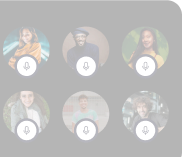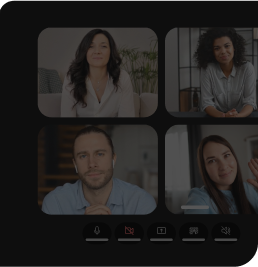In today's increasingly connected world, video communication has become a critical component of many apps and platforms. From video conferencing to live streaming, businesses and consumers alike expect seamless, high-quality video experiences. This is where Video SDKs come in.
A Video SDK, or Software Development Kit, gives developers the necessary tools and APIs to incorporate video communication into their applications. Choosing the right Video SDK is crucial, as it can have a significant impact on the quality and performance of your app.
In this article, we will explore the must-have features of a Video SDK and what factors you should consider when choosing one.
Key Factors to Consider When Choosing a Video SDK
Before diving into the must-have features of a Video SDK, it's essential to consider the key factors that can impact your decision. These include:
- Platform support: Does the Video SDK support the platforms you plan to develop for (iOS, Android, Web, etc.)?
- Quality of video and audio: How does the SDK handle video compression, resolution, and audio quality? What is the Default video quality? What are the standard settings for video resolution, frame rate, and bit rate? Is it configurable?
- Ease of integration: Is the SDK easy to integrate with your existing codebase and development environment?
- Customizability: Can you customize the UI and functionality of the SDK to meet your specific requirements?
- Scalability: Can the SDK handle a large number of simultaneous users without sacrificing quality or performance?
- Reliability: What happens if there is a connection issue or outage? How does the SDK handle these situations?
- Security: How does the SDK handle user authentication, data encryption, and other security concerns?
- Cost: What is the pricing model for the SDK? Are there any hidden costs or restrictions?
- Error Handling: How does the Video SDK handle crashes, buffering issues, or poor video quality?
10 Must-Have Features for a Video SDK
Now that we've covered the key factors to consider, let's dive into the must-have features of a Video SDK. These include:
- Real-time video communication capabilities: This is the most fundamental feature of any Video SDK. It allows you to conduct live video calls, conferences, and live streaming within your app in real time. A reliable and high-quality real-time video experience is critical for many use cases, such as telemedicine, online learning, remote work, and social media apps.
- Screen sharing: Screen sharing is an integral feature of many video conferencing and collaboration applications that lets users to share their screens with other participants in a call or conference. This feature is particularly valuable for remote teams and online learning, as it facilitates virtual demonstrations, presentations, and training sessions. (Did "Can you see my screen" echo in your ears too?)
- Recording and playback: The ability to record and playback video calls or conferences is vital for post-meeting analysis and future reference. This feature is particularly valuable for customer support, events like webinars, sales meetings, education, and training.
- Chat functionality: The ability to send and receive chat messages during a video call or conference is essential for real-time communication and collaboration. Chat functionality allows users to communicate quickly and efficiently without interrupting the ongoing video conversation.
- Background noise cancellation: Background noise cancellation is a critical feature that helps filter out unwanted sounds and distractions from the environment. This feature improves audio quality by focusing on the speaker’s voice while minimizing background noise, making it easier for all participants to hear and understand each other. (This lets you stress let about your dog barking or your neighbour honking)
- Low-latency streaming: Low-latency streaming is crucial for delivering a seamless and uninterrupted video experience, particularly for live events and gaming applications. This feature minimizes the delay between when the video is captured and when it's displayed on the viewer's screen, resulting in a more natural and engaging experience.
- Adaptive bitrate streaming: Adaptive bitrate streaming is a technique that adjusts the video quality based on network conditions, ensuring a smooth and stable connection, irrespective of network congestion. This feature is particularly important for mobile and low-bandwidth connections.
- Multi-participant support: Multi-participant support enables developers to create video conferencing apps that can host calls or conferences with multiple participants, each with their own audio and video feeds. This feature is essential for team collaboration, webinars, and video-based social platforms.
- Virtual backgrounds: Virtual backgrounds allow users to replace their physical backgrounds with virtual ones. This feature is popular in video conferencing and live streaming applications, offering users privacy and a more professional look. (Worry less about your roommate roaming around or clearing up the pile of clothes.)
- AR filters and effects: AR filters and effects enable users to add augmented reality elements such as masks, hats, and costumes to their video feed. This feature has become increasingly popular in social media applications, resulting in more engaging and interactive content creation. (Go ahead and add those puppy filters on your sync-ups.)
Conclusion
In conclusion, choosing the right Video SDK is crucial to delivering high-quality, seamless video experiences in your app. By considering the key factors and must-have features outlined in this guide, you can make an informed decision that meets your specific needs. It's also worth noting that there are many Video SDK providers available, each with its own strengths and weaknesses. Research and compare different options to find the best fit for your app. With the right Video SDK, you can take your app's video capabilities to the next level.
And if you are looking for a video SDK that’s developer developer-friendly, secure, and lightweight, well, hello from Dyte.
Let us help you get started. If you’re curious about what Dyte is capable of, here are some resources to start off your research:
Interested? Let’s talk and figure out what Dyte can do to make the development of your video app smoother.
FAQs
Can Video SDKs be customized?
Yes, Video SDKs can be customized to meet the specific needs of your application. Most SDKs provide APIs and libraries that allow developers to customize and configure important features like resolution, frame rate, and bit rate.
How do I choose the right Video SDK for my application?
When choosing a Video SDK, it's important to consider factors such as pricing, ease of use, supported platforms, security, and scalability. You should also evaluate the features and functionality of each SDK to ensure that it meets your application requirements.



